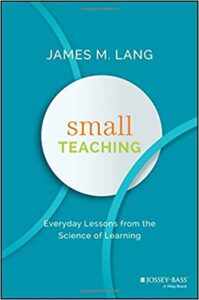This post is by Gina Bennett.
FIRST, a short retrieval quiz:
-
In Chapter One, Lang describes 3 different studies to demonstrate how effectively regular quizzing improves retrieval. Can you name any 2 of the subject areas involved?
-
Also in Chapter One, Lang suggests that the frequency of quizzing is critical to the success of this technique. How often (as a minimum) does he recommend that quizzes be given?
Big Idea: Long term mastery of a series of related topics is fostered by spacing out the learning activities over time, introducing new topics before the previous topic has been mastered and intermixing new skills with previously developed skills.

I picture this as the “2 steps forward, 1 step back” approach.
Theories, Principles, Models, and Tips
Lang begins his discussion of the theory behind interleaving with a study that illustrates the difference between massed and spaced practice. Massed practice is defined as time focused entirely on learning one skill or topic until it is mastered, while spaced practice is pretty much the way it sounds: the learning related to that particular skill or topic is spread out and interspersed with time spent doing other things. Interestingly, some of those “other things” include forgetting what’s just been learned. This sounded counter intuitive to me, but as Lang points out, forgetting forces us to really work at the process of retrieval and more strongly embeds the learning in long term memory. Allowing time between learning sessions like this not only forces us into a cycle of forgetting and retrieval, it also gives our brains time to consolidate the new material. This process leads to what’s referred to as “durable learning” — another great term I picked up from this chapter.
Several of the models for incorporating interleaving sound pretty similar to suggestions for improving retrieval (e.g. frequent quizzing), except that here we see a more pronounced emphasis on the inclusion of quiz questions from material learned in the past. A very nice small teaching tip is to end a lesson by asking students to create a test question based on what they learned that day — & instead of waiting for the final or midterm, ask a couple of those questions a few weeks later. And I like Lang’s suggestions for coaxing students to apply previously acquired skills or knowledge to new contexts — transfer of learning is always an issue and I can certainly appreciate how interleaving will help make that happen.
Concerns, questions, musings
I am so tempted to try to sell an interleaving approach a little harder in my ABE math class because the most profound research results mentioned by Lang (and others) are based on students studying middle school math. However, the [adult] students I know who are working at that level usually do not welcome (or need) more frustration in their lives. That concern about feeling discouraged due to lack of a sense of mastery — that’s a major concern. And the students working in a more advanced ABE math course know full well that this course is “terminal;” consequently they are not keen to struggle more than they need to at something that they will “never use again.” I would be very interested to hear what others familiar with the ABE learner audience think about that.
Not a concern but a confusion: I am a bit mystified by Lang’s description of how to employ interleaving in an online learning environment. I suspect his concept or experience of online courses is different from a lot of the ones we offer here. He refers to the “distribution of deadlines” but in my experience most online courses do this anyway. It seems that many of Lang’s examples so far are largely based on “traditional” students: full-time young people who attend on-campus classes in a semester-based format
FINALLY, an exercise in prediction:
In this chapter, Lang describes how interleaving improves the embedding and retrieval of knowledge. Can you think of some ways in which interleaving might also improve understanding?
Links, other interesting things
-
Nice website from the University of Arizona with lots of supplementary material (e.g. blog posts, explanations, PPT slide deck) about interleaving
-
Learning how to Learn is a free MOOC offered on a regular basis by Coursera. If you are interested in learning science and would appreciate an entertaining and accessible approach, you’ll like this course.
-
Have any of you come across the Pimsleur method of language learning? Dr. Pimsleur was a big fan of spaced practice and he developed a schedule of optimal spacing, a system he called “graduated interval recall.” His scheduling sounds like Lang’s spacing recommendation on steroids.
Answers to the retrieval quiz:
-
The 3 studies Lang refers to to demonstrate the efficacy of retrieval practice involved students learning Social Studies, Art History, & Chemistry.
-
Lang states (under subheading “Principles”) quizzes should be given at least once a week (preferably in every class).
Image: “interleaving sign” is CC0 – I drew it myself -gb
What strategies are you using? Share your ideas in the online Chapter discussions in Mattermost or join us for the live web conference meetup for Chapter 3 on Friday, September 27th at 11:00am.
See How to Participate.



 Small Teaching is “an approach that seeks to spark positive change in higher education through small but powerful modifications to our course design and teaching strategies”
Small Teaching is “an approach that seeks to spark positive change in higher education through small but powerful modifications to our course design and teaching strategies”  All are welcome who are interested in teaching and learning, sharing ideas and exploring our Book Club as an informal and fun way for us to learn together and meet new people in our community.
All are welcome who are interested in teaching and learning, sharing ideas and exploring our Book Club as an informal and fun way for us to learn together and meet new people in our community.